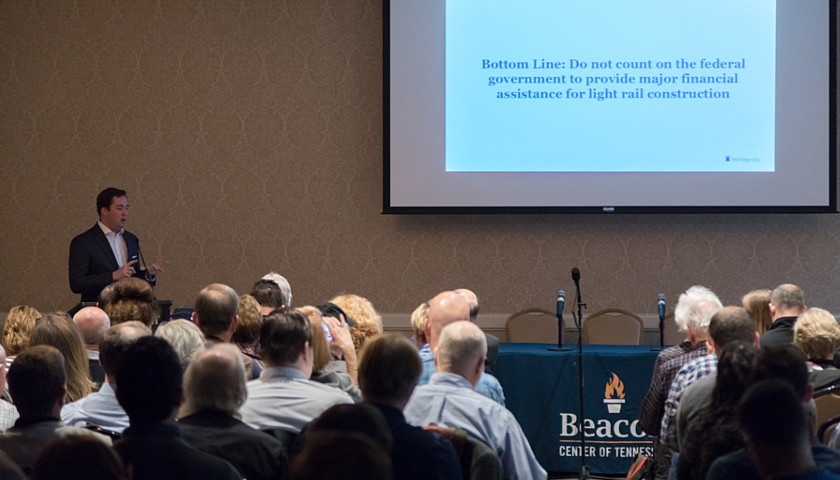NASHVILLE, Tennessee — The Beacon Center of Tennessee hosted a free conference open to the public on Saturday featuring the nation’s foremost experts discussing “Off Track: What’s Wrong with Nashville’s Transit Plan & What We Should Do Instead.” The title reflects the sentiment of attendees, primarily interested citizens versus special interest groups, that there is a congestion problem in the greater Nashville area that needs a solution, but one that is more efficient and cost effective than the $9 billion Let’s Move Nashville plan being put to referendum on May 1.
![]() The event included two power-house panels, the first on “What’s Wrong with the Nashville Plan,” featuring Randal O’Toole, Senior Fellow of the Cato Institute; Michael Sargent, Policy Analyst, Transportation and Infrastructures from the Heritage Foundation; and, Ron Shultis, Policy Coordinator of the Beacon Center of Tennessee, moderated by Ralph Bristol, former WTN 99.7 Nashville Morning News Host.
The event included two power-house panels, the first on “What’s Wrong with the Nashville Plan,” featuring Randal O’Toole, Senior Fellow of the Cato Institute; Michael Sargent, Policy Analyst, Transportation and Infrastructures from the Heritage Foundation; and, Ron Shultis, Policy Coordinator of the Beacon Center of Tennessee, moderated by Ralph Bristol, former WTN 99.7 Nashville Morning News Host.
The second panel included Transportation Policy Analyst Baruch Feigenbaum from the Reason Foundation; Marc Scribner, Senior Fellow of Competitive Enterprise Institute; and Emily Hamilton, Policy Research Manager, Mercatus Center, moderated by Beacon Center of Tennessee President and CEO Justin Owen and focused on “A Better Plan for Nashville.”
John Cerasulo, Chairman of the Board of Directors of the Beacon Center of Tennessee, in his opening remarks, said with the Let’s Move Nashville plan at a cost of approximately $9 billion being the largest and most expensive project in Nashville’s history, it deserves further discussion and debate. Everyone having heard the plan and “plenty on the pro-transit side,” an alternative view would be presented.
Perhaps more insidious, Cerasulo pointed out, is that the mayor has said, “There is no Plan B,” adding, “It’s either the mayor’s plan or total gridlock, complete chaos, dogs and cats living together.”
![]() Randal O’Toole, as the first presenter, had no problem livening the room early on a Saturday morning, opening with a slide of a 1938 train while making the point that he loves passenger trains, helped restore the vintage Baldwin in the picture and owns four of the rail cars. But, he added, light rail should be called “lie rail,” because it weighs more than heavy rail. The “light” refers to capacity.
Randal O’Toole, as the first presenter, had no problem livening the room early on a Saturday morning, opening with a slide of a 1938 train while making the point that he loves passenger trains, helped restore the vintage Baldwin in the picture and owns four of the rail cars. But, he added, light rail should be called “lie rail,” because it weighs more than heavy rail. The “light” refers to capacity.
After rattling off a dizzying array of statistics accompanied by slides that put the “one picture is worth a thousand words” into action, O’Toole was followed by the other two panelists with their presentations who then joined together for a Q&A session. After a brief break, the same process was repeated with the second panel.
The information presented, so thorough, in-depth and data-driven, had many attendees taking pictures with their cell phones to capture the slide presentations while furiously writing notes on event topics that included: Federal Light Rail Funding: Trends and Tribulations; Crazy Train: The Wrong Plan for the Music City; A Cost-Effective, High-Quality Transit Solution; The Future of Passenger Surface Transportation is Trackless and Driverless.
Using the popular television program Shark Tank format, Beacon Center’s Shultis framed his presentation around four questions: How much are we investing, how long to recoup our investment, how risky is the investment and what can we expect for our returns.
![]() Answering those questions revealed some shocking data including a per person cost for the completed plan of $13,080 or $33,882 per household to Nashvillians. Even adjusting for the plan’s purported 47 percent of sales tax coming from outside Nashville, the cost is $5,320 per person or $13,782 per household. The estimated completion date for the current plan is 2032, which translates into congestion plus 14 years of construction. However, the increased taxes to fund it will go more than three decades longer until 2068, meaning that, on average, only those born in 1990 or later will be alive when the tax surcharges expire.
Answering those questions revealed some shocking data including a per person cost for the completed plan of $13,080 or $33,882 per household to Nashvillians. Even adjusting for the plan’s purported 47 percent of sales tax coming from outside Nashville, the cost is $5,320 per person or $13,782 per household. The estimated completion date for the current plan is 2032, which translates into congestion plus 14 years of construction. However, the increased taxes to fund it will go more than three decades longer until 2068, meaning that, on average, only those born in 1990 or later will be alive when the tax surcharges expire.
Seeming somewhat obvious once mentioned, post-World War II regions, after the automobile had been introduced, call for different transportation plans than pre-World War II, which were developed around walking and streetcars and have very high central city densities. The post-World War II region solutions include managed lanes with transit, managed arterials with transit, general purpose lanes, bus-based transit system, ITS (Intelligent Transportation System) features, most of which don’t seem to have been considered in the Let’s Move Nashville plan.
Arguably, the most noteworthy point was a comparison of the same $4.3 billion to get 29.9 miles of light rail in the Let’s Move Nashville plan: Every existing bus could be replaced with two battery-operated buses as well the operation and maintenance costs and free bus rides for 20 years; the entire 219 miles of freeways through the metro area could be expanded with an additional two lanes of elevated expressway at $7 million per lane mile; every single student in Metro Nashville Public Schools could receive a new Apple laptop computer every three years for the next 20 years. And, remarkably, there wouldn’t have to be a choice between those three options. All of them could be done for the $4.3 billion price tag for the light rail. “That’s how stupid” the light rail portion of Let’s Move Nashville Plan is.
Other notable highlights from the presenters:
- Compared to state-of-the-art buses, light rail is three times more deadly, can’t move as many people, and is more expensive. Light rail “solely serves the ego of the officials buying it.”
- Often used as a point of reference for Let’s Move Nashville proponents, Denver’s $4 billion plan in 2004 turned into $7 billion after cost overruns. Its Flatiron Flyer moves at an average of 21 mph versus bus rapid transit at 41 mph. Denver’s cost overruns were on par with the average, which is typically 40 to 50 percent on light rail projects.
- In 1980, 10 percent of commuters to downtown Portland, Oregon used bus transit. After investing in five light rail lines, two street cars and a commuter line – like Nashville’s Music City Star, in other words “a huge failure” – transit users decreased to 8 percent in 2016, while commuters who use their car or walk/bike both increased. Decreases in transit commuters have also been seen in Dallas-Ft. Worth, Denver, Houston and Sacramento after the addition of light rail. The share of commuters taking transit in all four cities was less than 5 percent, even at the peak of transit usage.
- Federal transit funding, relied upon in the Let’s Move Nashville plan, is not only not guaranteed, it’s very likely not to come. Only about $12 billion, or less than 0.5 percent of the $4 trillion in total federal spending goes towards transit. Under the Trump administration, Capital Investment Grants for light rail and streetcar funding has been reduced to one third of that under Obama.
- Just 3.6 percent of the commuters to Nashville’s Central Business District (CBD) use transit, lower than comparative cities such as Atlanta and Portland, which are 14.2 and 27 percent, respectively, but ahead of Indianapolis at 2.6 percent. The highest is New York at 76.6 percent.
- Costs to build and operate bus-based transit service is between 1/3 and 1/9 the cost of building rail lines.
The political action committee to defeat the May 1 referendum, NoTax4Tracks.com, was introduced by Lee Beaman.
The Beacon Center of Tennessee plans to post online the video of the event.






Musk has gotten rich on the backs of the American taxpayer with a subsidy paid by us for his cars
[…] partnerships. These ideas have their critics—the conservative Beacon Center of Tennessee has criticized virtually everything Barry’s ever done—and that’s […]
Everything works in a vacuum, with no friction or counter force. The more I hear about this whole plan, the more I simply see people excited about spending other people’s money. And it’s not going to really solve anything.
Offer Bezo and Musk the opportunity to work closely with the city of Nashville and future transits plans. That 9.2 Billion could be spent on self driving cars and infrastructure. As gig work becomes more prevalent or the service industry grows, a version of a 12 seat “people wagon” with a “uber” platform would create 12 less vehicles on the road all over Nashville for the benefit of all. And it works with the TOD. Retail is changing to a VR format and PU/Delivery. Rail doesn’t work. If it works the corporate partner gets his rewards along with my grandchildren. The plan offered is NOT PROGRESS. It cannot be considered PROGRESS if it hurts many and helps a few.